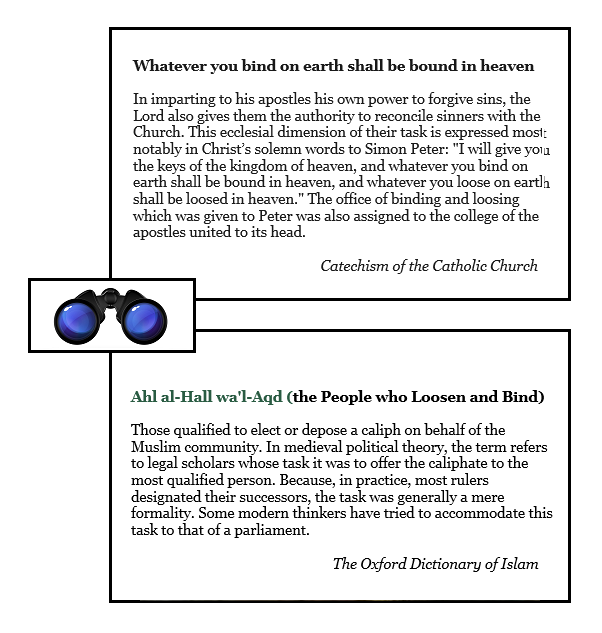Brief brief: of binding and loosing
[ by Charles Cameron — really just a note to myself, but you may read it over my shoulder ]
.
Joas Wagemakers, blogging on Jihadi-Salafi views of the Islamic State at the Washington Post, was talking about the “caliphate” today, and as usual, I went off on my own DoubleQuoting tangent:
**
Here’s Wagemakers’s para that triggered the above:
In 2014 the Islamic State of Iraq and Syria set itself apart from most other radical Islamist groups by actually settling in a certain territory and establishing a state there. The group even declared a caliphate on June 29 and changed its name simply to the Islamic State (IS). Even al-Qaeda, which has long had similar ambitions to establish a caliphate encompassing all Muslims, has never achieved this. In its justification for the announcement of its caliphate, IS has made use of classical Islamic concepts: its leader, Abu Bakr al-Baghdadi, had been vetted by a group of scholars described as “the people who loosen and bind” (ahl al-hall wa-l-aqd), was found by them to be a pious Muslim ruler who fit all the criteria for a caliph and was therefore worthy of believers’ oath of allegiance (baya).
Do I detect an echo here, between the two phrases — or is the concept of loosing and binding so basic to human experience that it crops up all over?
It’s a question at the intersection of two of my fields of special interest — depth psychology and cultural anthro — see for example Anthony Stevens, writing under the subtitle Archetypes versus cultural transmission:
Essentially, the theory can be stated as a psychological law: whenever a phenomenon is found to be characteristic of all human communities, it is an expression of an archetype of the collective unconscious. It is not possible to demonstrate that such universally apparent phenomena are exclusively due to archetypal determinants or entirely due to cultural diffusion, because in all probability both are involved. However, the likelihood is that there will be a strong bias for those phenomena which are archetypally determined to diffuse more readily and more lastingly than those that are not.
**
Now go read Wagemakers.




January 29th, 2015 at 1:31 am
Seems to be a standard formula used by Jewish religious lawyers. It’s use by the Lord is well within recognized 1st-century usage. The few contemporary sources of the 7th century suggest a heavy Jewish presence among the Saracen conquerers. Its possible adaption from the rabbinate to the ulema could have happened then or earlier in the then religiously fertile northwest Arabia.
January 29th, 2015 at 3:11 am
Greatly appreciated, Lynn.